
Nov. 20, 2024
Welcome to IDEAL's ultimate guide to Powder Coat Finish!
Our blog is a comprehensive resource for anyone interested in learning more about this versatile and affordable surface finish option.
Everything You Need To Know About Powder Coat Finish
Powder coating is a popular finishing option in the rapid prototyping industry. It is a great way to impart improved physical and mechanical properties on custom machined parts.
This method of coating has been used since the early days of powder metallurgy and has become increasingly popular. It is widely used in industry today because of its numerous advantages, including corrosion resistance, high-quality surface finishing, and long-term environment-friendly impact.
So, what types of powder coating? how does it work? and tips for perfect powder coat finish. This article will address all of your concerns about powder coatings.
What is Powder Coating?
Powder coating is a type of coating that is applied as a dry powder to a surface and then cured under heat. The powder may be a thermoplastic or a thermoset polymer. It is usually used to create a hard finish that is tougher than conventional liquid coatings, which can be used on plastic, glass, or metal surface.
The powder coating is usually done by electrostatic spray deposition (ESD) or fluidized-bed application. Both two methods provide great gloss levels, textures, various colors, and high-quality surfaces, making them used on a variety of products, including medical devices, architectural applications, automotive, and even fiberboard avionics.
Types Of Powder Coating
Powder coating is usually divided into two main categories. There are thermoplastic, thermosets. In addition, there are also divided into three categories, including Thermoplastic, Thermoset, and UV Curable Powder Coating. The UV curable is the most advanced technique.
This article will introduce three types of powder coatings. You can decide which type to choose based on the parts’ materials, durability, cost-effectiveness, and quality.
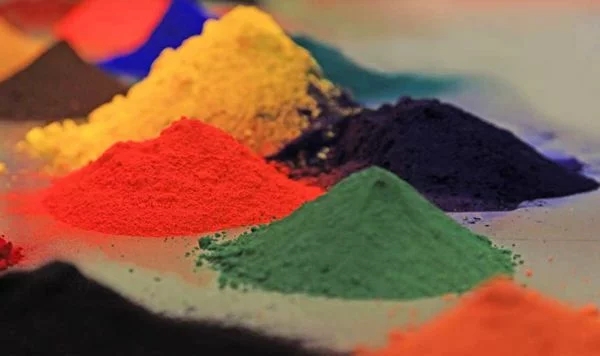
Thermoplastic Powder Coat Finish Materials
Thermoplastics are those which soften with heating and can be processed after that to gain specific strength and chemical properties with cooling. In thermoplastic powder coating, the dry powder is coated on desired part/material with heating the powder melts and covers the desired workpiece, and gains the specific mechanical strength on cooling.
Specifically for industrial purposes, thermoplastic coatings are implemented for endurance, esthetics, and safety purposes. Some of the thermoplastic powders used in the industry are mentioned below.
Nylon
Nylon is an excellent thermoplastic powder coating material with excellent durability and impact resistance. It is FDA approved and food graded, that is why it is commonly used in household and kitchen products such as dishwashers and for food storage items. It also has a low friction coefficient, which makes him ideal for the surface finishing of gears and mechanical Tools.
Polyvinyl Chloride (PVC)
The PVC coating is introduced in the market when the powder coating is in its initial stage, these coatings are pliable, sleek, and durable and show resistance to most of the solvents. polyvinyl-chloride is engineered with the polymerization technique in the presence of vinyl chloride, and it is produced in the industry on large scale. The basic benefit of these coating is in terms of chemical and electrical insulation. Moreover, they have excellent spray resistance, FDA-approved food staining resistance, and good dielectric and physical strength.
Polyester
The polyester coating is famous for its durable finish, weather and temperature resistance, esthetic look, and for its resistance to abrasions. For these reasons, this type is mostly used for outdoor automobile and avionics parts. Due to their aesthetic looks and physical strength, they are also ideal for architectural purposes.
Acrylic
Acrylic powder coating shows high-quality surface esthetics and high impact resistance, this process needs a little bit high curing temperature, that’s why it is mostly considered an expensive powder coating.
It shows excellent alkali resistance which is ideal to be used for components like washing machines and ship structures. Acrylic powder coating is applicable through electrostatic spraying to get ideal chemical resistance, weather ability outstanding smoothness, physical strength, and durability.
Thermoset Powder Coat Finish Materials
In thermoset powder coating The thermoset resigns are broken down to powder material, Which is fabricated on the desired material as a thin film. They provide improved chemical and physical characteristics in the aspect of esthetics, and corrosion resistance than ordinary oil coating.
In the modern, the thermostat material technology improved a lot, The ability to engineer thermostats resigns to increase their physical and chemical properties as per the targeted object, improving this niche a lot in specialized roles in surface finishing technique. The following are two common thermoset materials.
Thermoset Powder Coatings: These powders include resins that chemically react during curing, creating a solid, durable finish that won’t remelt under heat. They are common for outdoor applications due to their UV resistance and durability.
Thermoplastic Powder Coatings: These powders melt and flow when heated but do not chemically react. This makes them more flexible and impact-resistant, suitable for applications where flexibility is needed.
UV Curable Powder Coat Finish
UV curable powder coatings are a coating that cures under ultraviolet light. Unlike traditional methods, which require heat to cure, UV curable powder coatings can be cured at much lower temperatures. This makes them ideal for use on delicate or heat-sensitive materials. It also has a shorter curing time than traditional powder coatings.
UV curable powder coatings provide a number of advantages over traditional ones, including faster curing times, improved durability, and greater flexibility in terms of color selection. They are typically more expensive than traditional methods, but the improved performance can justify the additional cost.
How Does Powder Coating Process Work?
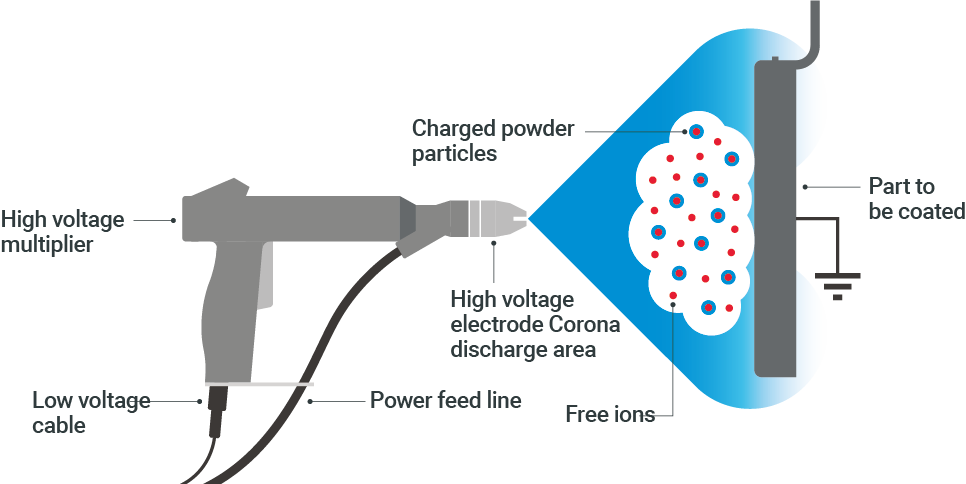
1. Preparation of the Surface
The success of powder coating depends on thorough surface preparation. This stage ensures that the powder adheres effectively and that the coating is even and durable.
Steps may include:
Cleaning: Dirt, grease, and other contaminants are removed from the surface using degreasers or solvents.
Abrasive Blasting (Sandblasting): If there are old finishes, rust, or stubborn residues, sandblasting or another abrasive method is used to strip the surface.
Chemical Treatment: In some cases, a chemical etching or conversion coating (like a phosphate or chromate treatment) is applied to enhance corrosion resistance and improve powder adhesion.
2. Application of Powder
After preparation, the powder is applied using an electrostatic spray gun in a controlled environment:
Electrostatic Charging: The powder particles (made of finely ground pigment and resin) are given an electric charge as they exit the spray gun.
Electrostatic Attraction: The charged powder particles are attracted to the grounded metal part, forming an even layer across the surface.
Uniform Coating: The electrostatic process ensures that the powder adheres uniformly, even in hard-to-reach areas, and minimizes overspray waste.
3. Curing Process
Once the powder is applied, the part is transferred to a curing oven where heat causes the powder to melt, flow, and form a continuous, durable film. The curing process involves:
Heating: The coated part is placed in an oven and heated to temperatures between 300-400°F (150-200°C), depending on the powder type.
Cross-Linking Reaction: During heating, the powder melts and undergoes a chemical reaction (cross-linking) that bonds the molecules, creating a hard and smooth finish.
Cooling: After curing, the part is left to cool, which solidifies the coating and leaves it highly durable and ready for use.
Benefits of Powder Coating
Powder coating offers several advantages over traditional liquid paint:
// Durability: Powder-coated surfaces are resistant to chipping, scratching, and fading.
// Environmental Benefits: Powder coating is a more eco-friendly option because it doesn’t use solvents, resulting in minimal volatile organic compound (VOC) emissions.
// Efficiency: Overspray can often be collected and reused, reducing waste.
// Attractive Finish: Powder coating provides an even, vibrant finish and can achieve a wide range of textures and colors, including matte, glossy, and metallic effects.
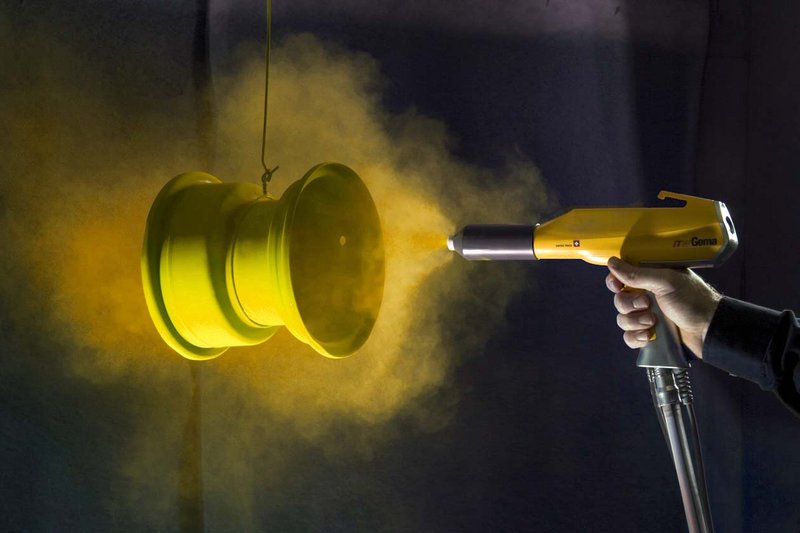
Granted, powder coating does have a few Disadvantages:
// Thick Coatings Only: For starters, the process limits you to thick coats along the surface of a given metal. In most settings, thin coats of a powdered polymer result in bumpy finishes akin to the skin of citrus fruit.
// Equipment Requirements: The second drawback — and the most prohibitive for smaller operations — is the amount of expensive, high-tech equipment required for a powder coat. In order to do powder coats, you need to have an industrial oven and an electrostatic booth in addition to the spray tools, all of which can be cost-prohibitive for the DIY craftsperson or home-garage mechanic.
// Color Matching: Liquid paint is easy to mix on-site, but powder coat colors are made with special production runs and determined by the plastics used to create them. Mixing colors together would just give you a speckled pattern. Also, many people reuse excess powder used in the application process, which can lead to further difficulty in matching up colors. This difficulty can reduce efficiency and make touch-ups more difficult, especially when using metallic colors.
// Minor Surface Limitations: Even though many consider powder coating the more durable and efficient option for finishes on metal surfaces, powder is not an option for rubber, which melts when subjected to the electrostatic process.
Nonetheless, you can conquer certain limitations associated with powder coating. For example, the subsequent cuts and touch-ups on an already-coated component can be avoided entirely with today’s advanced product modeling, which is made possible with 3D imaging. The presence of final-assembly engineers on a design team can also help make the process of powder coating more foolproof and hurdle-free.
Things to Consider With Powder Coating Materials
If you’re thinking about choosing powder coat over paint and adding it to your operation, there are a few aspects you’ll want to factor in when buying your supplies:
// Available Colors: Liquid paint offers practically endless color options, whereas powder coat colors can be more limited. Some powder manufacturers can create just about any color in powder form, while others are restricted to some basic colors. Some colors may call for special manufacturing runs, which will increase lead time. Consider whether the colors you can get meet your needs and how specific your future color-matching needs might be.
// Volume: Will you be able to meet your volume needs with your powder coating equipment? In addition to the capabilities of the equipment, consider the labor required and your access to materials, such as custom-ordered powder coat colors.
// Compliance: Are your equipment and processes compliant with the 9001:2008 standard from the International Organization for Standardization? This standard helps assure quality and good manufacturing practices.
// Quality of supplies: In addition to compliance, you’ll also want to consider how well your suppliers will support your operation overall. Both your equipment and coating materials need to come through reliable, trustworthy providers with proven track records of success. Look for well-made equipment, strong customer service and individualized solutions.
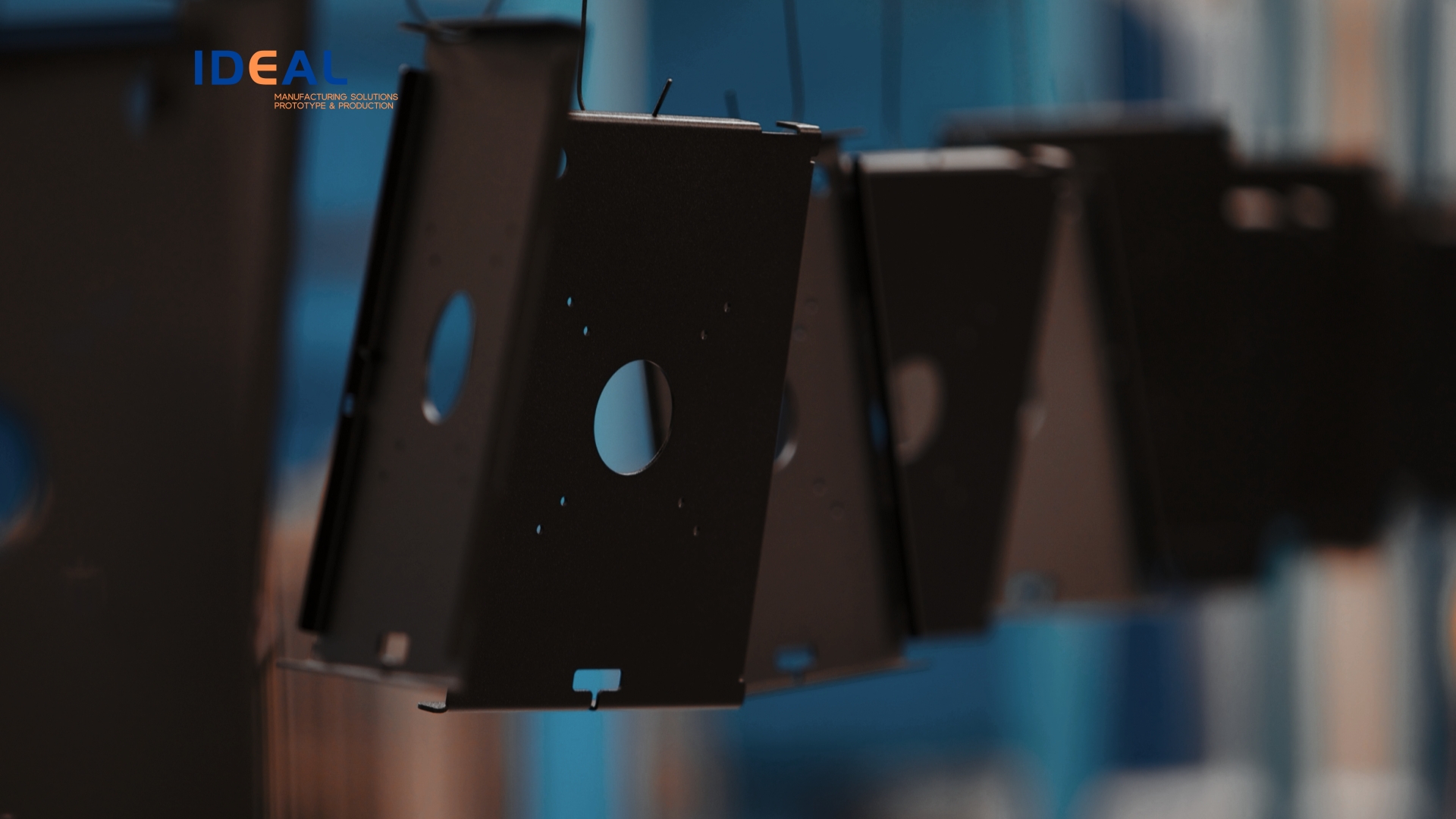
While powder coating has some special considerations in comparison liquid paint, if you take the right steps, it can provide a unique and advantageous finish to a wide range of metal components.
How Does Spray Painting Work?
Traditionally, industrial color coats have been achieved through the self-explanatory process known as spray painting, where paint is applied in aerosolized form through pump devices at high pressure. In the majority of applications, the paint is delivered via pneumatic-powered tools or machinery to achieve a consistent, even coat along a chosen surface.
Before you can apply a coat of spray paint to a chosen surface, you must clean the metal of oily residue and dirt. You then treat the surface to a wet-blast of roughly 15-20 micrometers. The process continues until you have evenly coated the entire surface with a sufficiently thick layer of paint.
The benefits of spray paint include:
// Self-drying. Wet paint dries on its own — no oven required — and so you can apply it to products that cannot submit to heat treatments.
// Color range. Paint can be rendered in a broader range of colors than powders and is useful for a wider assortment of products and signage.
// Thinness/texture. You can apply wet paint thinly to a surface and still leave a smooth texture. This makes paint the more suitable option for items that require thin coats.
// Affordability. Spray painting — and the tools required for the spray-painting process — is simpler and more affordable than powder coating.
With all the benefits of spray paint considered, the process also has its downsides. First off, paint layers lack the durability of powder-coated finishes. Over time, a coat of spray paint will require touch-ups. In most cases, the painted surface will need an entirely new coat of paint after a number of years.
Generally, it is also more difficult to achieve an even coat with wet paint. Whereas powder coats apply smoothly and evenly, paint can leave trace marks and be under-applied in certain areas, over-applied in other areas, and drippy along points. It usually takes multiple coats to achieve a smooth, even finish with spray paint.
Paint vs. Powder Coating: Which Is Better?
In the powder coating vs. painting debate, numerous questions abound. How durable is powder coating? Is powder coating better than painting? The answer could really boil down to which of the two processes best meet the following criteria.
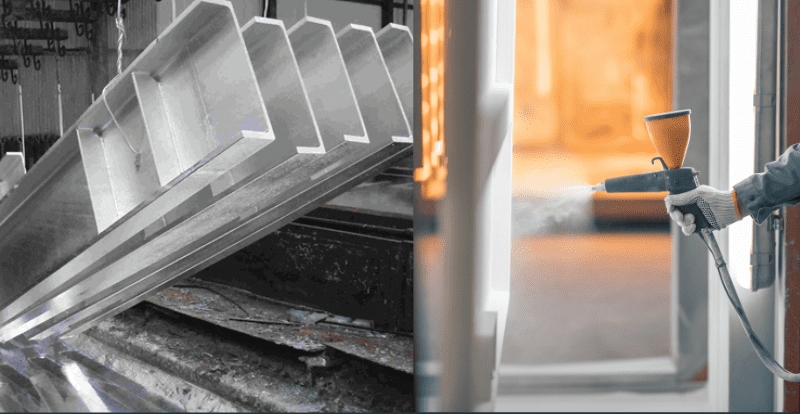
1. Cost Efficiency of Paint and Powder Coating
When economic factors are taken into consideration, the main benefit of the powder-coating process is its efficiency. With a general transfer efficiency of 60–70%, roughly two-thirds of the powder used for a given application serve the intended purpose. Paint, by contrast, has a transfer efficiency of only 30-35%, and thus wastes two-thirds of the paint used for a given application.
Even when you take the leftover amounts into account, all is not lost with powder applications. Once a powder coat has completed, the percentage of powder that falls aside can be collected and put back to use in the next cycle. No such form of conservation is possible with spray paint, which spreads into thin air if it fails to reach its target the first time.
Often, spray paint is more likely to cost less than powder coatings upfront. However, when you consider the loss of product you experience with spray paint, the extra expense may be worth the money. It’s up to you to determine what is manageable for your budget while meeting project demands.
2. Safety of Painting and Powder Coating
Compared to spray painting, powder coating is a safer process because the active product — polymer powder — is inert and therefore free of toxins. Paint, by contrast, usually has toxic solvents and volatile organic compounds that can be harmful if inhaled.
While you do need to wear protective gear when applying powder coats, the process itself is generally cleaner and free of health-related risks. That said, it is crucial to keep the powder from making contact with your skin, but this is easy to achieve thanks to the low amount of overspray that results from the process.
Additionally, paint comes with more storage demands. Spray paint is flammable, so it needs to be kept away from high heat. If you operate in a facility where this storage requirement may be challenging to manage, powder coatings are a better option.
3. Environmental Friendliness of Powder Coating vs. Painting
The eco-friendly advantages of powder extend well beyond the application process itself. Since there are no toxins or volatile organic compounds found in powder polymers, unused portions do not emit greenhouse gases, whether used or unused. Since the majority of a given powder supply ultimately does get put to use, the option is also easy on landfills. To the contrary, each application of spray paint sends toxins into the atmosphere.
4. Mechanical Convenience of Powder Coats vs. Paints
From a mechanical standpoint, powder coats offer greater degrees of strength and flexibility than spray-painted finishes. For starters, a powder finish has a thickness that is stronger and more difficult to crack or peel. Powder finishes are also more bendable, and this makes powder a better option for items that change shape, as well as for anything with moving parts.
The flexibility of powder coats makes powder the ideal option for transportation equipment, which is subject to constant movements and vibrations. Powder-coat finishes have also shown to be more resilient in the face of pebbles, flying debris and other hazards that get kicked up by the tires of a moving vehicle.
While a thick coating is often ideal where durability is concerned, some projects may require a thin coat. Thin outer coatings may be a demand for functionality or aesthetics — in these cases, powder coatings are not the best option. While it’s possible to thin a polymer for powder coating, it typically results in a course bumpy surface.
5. Productivity of Powder Coats and Paints
Powder coats also help speed along the production process thanks to the short time it takes for powder polymers to cure on a surface. Unlike paint, which may need days to fully dry, powder will fully cure in 20 minutes or less. A powder-coated part could ultimately be put to work even before it has cooled down from its time in the oven.
Due to the durability and streak-fee quality of powder coats, the process involved with powder applications is now seen as a necessary skill at production plants, where the process is commonly taught to staff.
If you work in a large facility with extensive project demands and tight timelines, powder coatings make it possible to keep up. When you run a small business with fewer scheduling limitations, spray paint is more likely a plausible option.
6. Color Accessibility of Powder Coats and Paints
When it comes to color-matching, wet paints offer the advantage of showing their final, dry-state colors right from the start. This makes it easier to mix and match paints with greater accuracy and achieve hues that are slightly off the basic color scale.
Any place you turn to for wet paint, the supplier can easily mix primary and secondary colors to achieve the exact match of a required hue. Alternately, the supplier could add black or white into the mix and equal the tint, tone or highlight of a specified color.
By contrast, the blending of powder colors involves a specialized production, in which the hue of a given color relies on the polymers that are broken down to form the powder. Consequently, the hue of a mixed color can be difficult to determine in advance. Unlike liquid paints — which blend properties when mixed — different powders will not coalesce into a pure, uniform color. Instead, a speckled combination of colors will form when powders mix into one.
7. Reliability of Painting vs. Powder Coating
When it comes to metal surfaces, the purpose of a paint or powder finish is twofold. On one hand, the coat is meant to offer aesthetic appeal, especially if the surface is part of a commercial product, such as a home appliance or automobile. More importantly, however, are the protective qualities of paint and powder finishes, which safeguard metal surfaces from the corrosive effects of environmental elements.
If left exposed to water or moisture, metal can develop rust in spots. In the most concentrated of rust-afflicted areas, holes can form within the metal surface. A solid coat of paint or powder prevents these corrosive effects from taking root on the surfaces of metal, but only as long as the finish remains intact. Since powder finishes are stronger and more durable than paint coats, powder will generally guarantee superior, longer-lasting protection to the surfaces of metal-bodied products.
The colors of powder coatings also last longer thanks to the retentive properties of polymers, which mostly resist the chalking effects of moisture, heat and UV rays. Paints, by contrast, slowly undergo a breakdown in resins and fade from prolonged exposure to sunlight, moisture and heat. The powders that offer the best resistance to chalking are those made from polyester.
8. Texture Differences Between Powder Coats and Paints
Each approach is better suited to a different type of texture. While both can help you achieve a glossy finish, it’s much easier to do with liquid paint. Thin powder coats are more textured and will feel a bit like the skin of an orange. The thicker the coat, the smoother the texture. Depending on which type of finish you’re going for, powder coating and painting will affect the difficulty of the process.
9. Equipment Requirements for Powder Coating vs. Spray Painting
Powder coating requires electrostatic equipment and curing ovens to be effective, and these can be large-scale investments for your operation. For spray paint, all you need is a spraying system and a spot to air dry.
The equipment demands for powder coating can be challenging for smaller businesses. When considering if these purchases are worth the investment, you’ll want to think about the types of projects you work on and if powder coats are better for meeting those project specifications. If the high durability and productivity of these coatings aren’t an absolute necessity, spray painting is an effective option.
Common Applications of Powder Coating
Powder coating is used on a wide range of products and components. The powder coating process involves cleaning and prepping the surface, applying an electrostatically charged powder, and curing it in an oven. This method provides a resilient, attractive, and environmentally friendly finish, making it a popular choice for industrial, automotive, and consumer products alike.
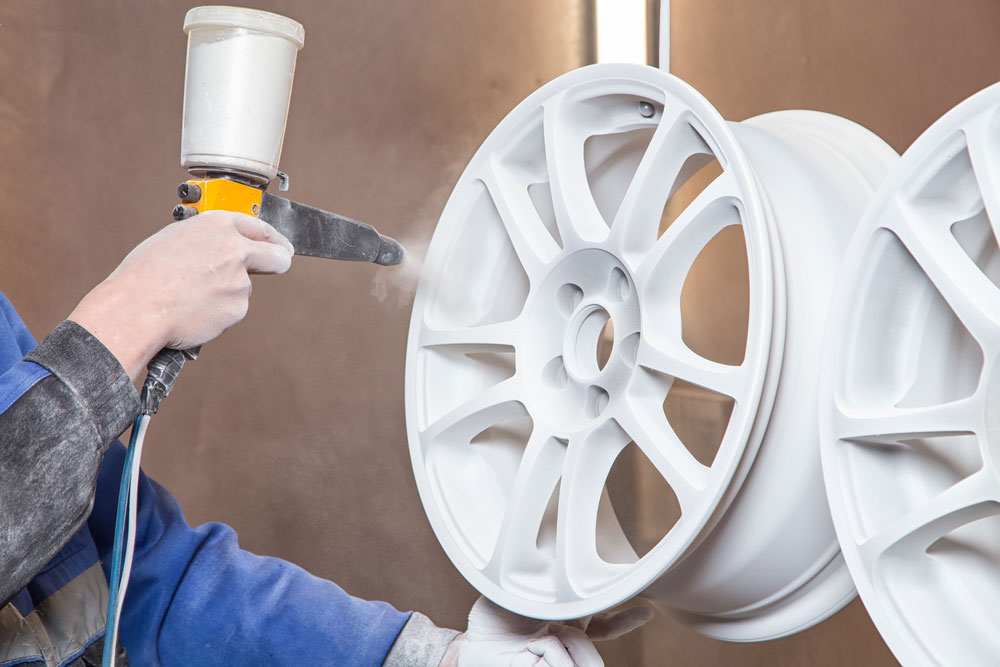
Automotive and Motorcycle Parts: Such as wheels, frames, and engine components, due to its durability and resistance to high temperatures.
Appliances and Furniture: Refrigerators, washing machines, and outdoor furniture are often powder-coated for protection and aesthetic appeal.
Industrial Equipment: Toolboxes, racks, and machinery are powder-coated for improved durability in harsh environments.
Conclusion
At IDEAL, we excel in providing top-quality custom machining services tailored to meet your project needs. Our advanced technology and skilled team ensure your specifications are met with exceptional accuracy and efficiency.
Contact IDEAL today to see how we can assist with your next project!

Search Blog

Hey there, I'm Abby!
At IDEAL RAPID PRODUCTION, I'm a Project Management Expert in custom manufacturing field for more than 15 years. We offer cost-effective machining services from China. Ask for a quote for your ongoing or upcoming projects now!

3D Printing: Process, Pros & Cons, and Applications
Feb. 21, 2025

Vacuum Casting: Process, Pros & Cons, and Applications
Feb. 21, 2025


An Engineer’s Guide to Design for Manufacturing (DFM)
Feb. 20, 2025
GET IN TOUCH WITH US
Navigation
RESOURCE
Contact Us
Tel: 0755-36957776
E-mail: info@idealrp.com
Skype: +86 135 2877 3620
Whatsapp: +86 135 2877 3620
Add.: Shenghua Building, Songgang, Bao'an,Shenzhen 518105
Add.: Room 4, 16/F, Ho King Commercial Building, 2-16 Fa Yuen Street, Mong Kok, Kowloon, Hong Kong
